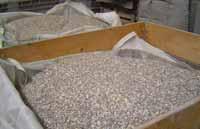PVC waste, as other waste materials, can be managed in three different ways: recycling; disposal with energy recovery (incineration) and as a last resort landfill.
Mechanical Recycling
Mechanical recycling of source-separated PVC is technically relatively simple and common practice.
Suitable post-use products are those which are easy to identify and separate from the waste stream or which can be kept relatively clean, ending up as a high-quality recyclate for use within the existing range of PVC applications.
Examples are: pipes (usually recycled into pipes), window profiles (recycled into profiles or pipes), flooring, roofing membranes, coated fabrics. These flexible applications are sometimes recycled via the Vinyloop process or reprocessed into products such as mats, traffic cones.
Recyclate from PVC applications which contain another material to fulfil their function, but cannot be separated into pure PVC (so called `composites') is only suitable for such applications where the mixed composition can be tolerated. PVC recycling operations, covering such products, have also been initiated.
Mechanical Recycling For Mixed Plastics
When homogenous plastics streams are not available, recycling schemes suitable for mixed plastics, including PVC, may be used. Mixed plastic waste containing up to 15 per cent PVC is not considered to pose technical problems, although the quality of the recyclate is suitable for a limited number of applications.
PlasticsEurope has studied this subject in depth. The technical report on `The mechanical recycling of mixed plastics waste', published October 1994, is available on request.
Feedstock Recycling
Feedstock recycling must be seen as complementary to mechanical recycling for two reasons: first to have technologies in place which are less sensitive to unsorted or contaminated waste products; and, second, to enlarge the overall recycling capacities for the larger waste quantities of the future.
In fact, there are a number of compositions or multiple material products which, when returned for recycling, cannot be economically sorted into generic (single) polymer streams. Examples of these are laminated films, ‘leather cloth', footwear or car dashboards, where the construction includes a number of different plastic and non-plastic materials.
These materials are intimately connected to each other for performance reasons but economic separation is not yet feasible.
The feedstock recycling processes operating today treat mixed plastics waste from packaging sources. This means with a PVC-content up to 10 per cent.
The ‘thermal cracking’ of this plastic waste stream can be done via hydrogenation, pyrolysis or gasification. Since the recovered hydrocarbon products are mostly used in petrochemical processes, the specifications limit the amounts of halogens in the waste below limits varying usually between 0.1 and 1%. One way to achieve this is to pre-treat the waste.
Such pre-treatment consists of a sorting or separation step of the used input - that allows adjusting the chlorine content of the main waste stream. A second possibility is thermal or chemical dehalogenation before the pre-treated product is further processed. This dehalogenation takes place either in a liquid or in a fluidised bed pyrolysis. The hydrochloric acid produced is neutralised or separated for industrial use.
The chlorine content of the resulting hydrocarbon feed can vary depending on the final processing step which is the determining factor. It is also common to dilute the chlorine-containing hydrocarbon feed with chlorine-free petroleum fractions coming from refineries. Thus relatively low PVC/chlorine content, as found in mixed plastics waste (coming mainly from short life applications such as packaging etc) is acceptable for the existing feedstock recycling processes as long as an appropriate pre-treatment of the plastics waste is guaranteed.
The feedstock recycling of a waste stream in which PVC is the dominant material (>30 per cent) - for example the multiple-material products as described earlier - has to be designed primarily for the recovery of hydrochloric acid, but also to recover the hydrocarbon content and/or energy.
Some commercial installations capable of handling large amounts of chlorinated waste are operating in Europe. A number of other processes have been proposed to specifically deal with this matter, such as, gasification in a metal or slag bath, and pyrolysis in a circulating fluidised bed. Most are at the concept or early development stage, but some have reached pilot plant stage, notably the process developed by Sumitomo Metals in Japan. A major operating step is to purify the HCI so that it can be fed as a gas to the oxychlorination unit in vinyl chloride monomer plant, the feed product for making new PVC, or to other chemical processes.
Download relevant documents here:









